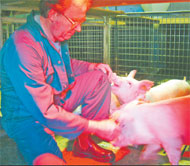
Live pig scans cap research career

At the culmination of a 40-year career, principal research scientist Roger Giles has delivered to pork producers and other members of the pig industry the latest information on using computer technology to assess pig carcase composition, in a seminar in Camden.
An information day at Elizabeth Macarthur Agricultural Institute (EMAI) highlighted co-operative research carried out by NSW Department of Primary Industries and the University of Sydney.
Latest pig health and biosecurity advice also featured in the information presented.
Dr Giles’ involvement in DPI’s pig science has provided a platform for collaboration between scientists at EMAI and the university.
He was instrumental in the introduction of CT scanning facilities at EMAI, which are capable of assessing composition in pig carcases and live pigs, unavailable elsewhere in Australia.
Using the scanner with live pigs reduces the number of animals slaughtered for research.
Highly respected and valued by colleagues as a lateral thinker with extensive knowledge, experience and linkages in numerous fields of pig science, Dr Giles has overseen one of the longest continuous periods in pig research in Australia.
Research on the effects of pig nutrition, endocrinology, environment and behaviour on performance, and assessment of carcase description and carcase composition have delivered many practical outcomes for the pig industry.
Contributions in research have been supported by continuous industry research funding and he has mentored numerous students.
Dr Giles’ significant legacy has been the development of a unique controlled-environment pig research facility at EMAI, able to house pigs in individual or group pens with complete variability in pen configuration and design.
Among his most memorable PR coups was his innovation in the late ‘90s of the ‘squeal-o-meter’ which registered whether there was a correlation between quieter or noisier pigs and the volumes of feed they consumed.
Dr Giles will continue to attend EMAI from time to time as a visiting researcher.
Email:

